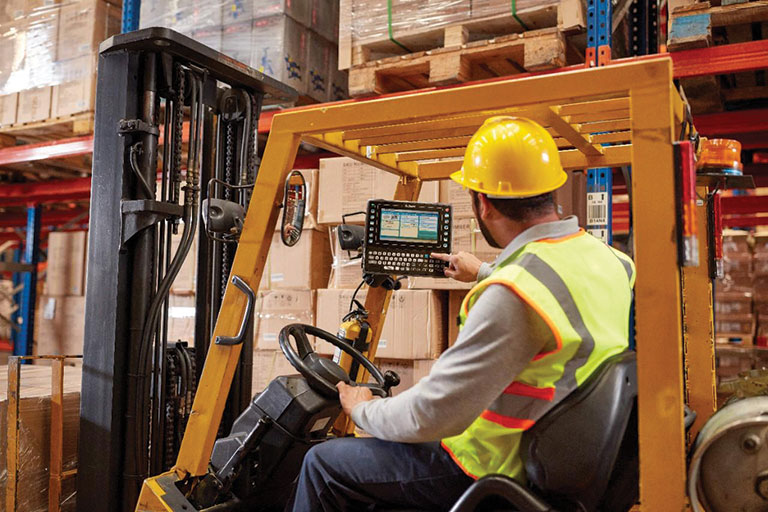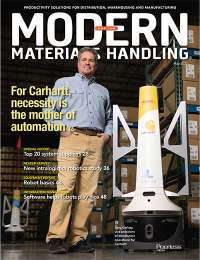Lift truck computing: Practicality reigns supreme
New operating systems and form factors aside, forklift computing gear needs to match conditions and save time for operators.

The computing gear on lift truck fleets has seen its share in innovations in recent years. The Android operating system (OS) has stepped in to dominate the segment, while new scan engines on tethered or wearable scanners can read bar codes at longer distances.
Such technology changes all should work toward a couple of common goals, say mobile device suppliers. They must be designed with the harsh operating conditions trucks need to work in and/or they should save time for operators.
Think of bar code labels such as shipping labels for outbound goods or pallets being crossdocked. Rather than centralizing the printing of bar codes, wireless thermal printers can be mounted to lift trucks to enable printing of bar codes on demand, says Nick D’Alessio, senior business development manager at Brother Mobile Solutions.
D’Alessio says Brother’s 4-inch-wide thermal printer often gets mounted to lift trucks to avoid the need to deal with batches of preprinted labels and give the flexibility to reprint labels or generate them on demand for fast-evolving situations like crossdocking a load of goods. An empty round trip to fetch labels, he says, is a time waster.
“We use [truck-mounted printers] at our own Brother warehouse in Tennessee, which is 1.5 million square feet,” D’Alessio says. “If you’ve got to go to a specific location where label printing happens to get a label, that can be long ride, so by mobilizing the printing, along with the rest of the computing, you can drive time efficiencies.”
Some facilities, including a major beverage manufacturer’s, says D’Alessio, have even mounted a larger 8-inch thermal printer on forklifts to enable printing of larger documents like packing slips, though the 4-inch sized printer suits most bar code labeling needs. Printers with dual radio capability, he adds, allow for either Bluetooth connectivity or Wi-Fi connectivity to warehouse management systems (WMS) or other host systems.
In terms of the computers for lift trucks, either a rugged tablet or a traditional fixed-mount computer can be a good fit, depending on workflow needs and environmental conditions, notes Mark Wheeler, director of supply chain solutions at Zebra Technologies.
Tablets work well for off-truck flexibility, but for conditions like cracked or rugged floors, or cold storage and freezer work, the traditional fixed-mount computer continues to shine because they typically have a high degree of shock vibration built in and have features like an integrated, heated keyboard instead of a touchscreen.
In cold storage environments, Wheeler explains, those heated keyboards prevent condensation from freezing and causing issues, and the physical keyboard is easier to use while wearing gloves. “Any environment where you don’t want to be completely dependent on capacitive touch working well is well suited to a vehicle mount computer with an integrated keyboard, so it tends to be selected for use by gloved operators, when dealing with condensation, or in food production where there are wash-down processes.”
Wheeler also sees a move toward mobile printers on lift trucks, primarily to save time. Another area of time savings is from newer tethered or wearable bar code scanners with scan engines capable of reading labels on pallets or storage locations at greater distances than in the past, which speeds up data collection. Zebra’s latest scan engines for tethered scanners can now read out to 70 feet, and its wearable scanner to about 40 feet.
Tablets have been making some inroads on vehicle mount computers, adds Wheeler, thanks to their flexibility off the truck and ease of a touchscreen to navigate systems like WMS with a graphical interface, but vehicle mount models are often chosen for the harshest environments.
A vehicle mount is also ready to take power from the truck, rather than having to add a power converter. Rugged tablets can be a good fit for some situations, and can run on Windows, but vehicle mount models such as Zebra’s VC8300 continue to appeal to operations that want an Android computer capable of dealing with harsh conditions.
“There are different variations to workflows that influence choice, but generally with lift truck computing, the thinking is: Give me something that is going to work reliably day in and day out, so that I don’t have to worry about having a truck down because a device went down,” Wheeler says. “It’s got to be extremely reliable and rugged.”

Article Topics
Brother Mobile Solutions News & Resources
Lift truck computing: Practicality reigns supreme Lift Truck Acquisition & Usage Study The next wave of mobile printing Datalogic and Brother Mobile Solutions expand allianceLatest in Materials Handling
Registration open for Pack Expo International 2024 Walmart chooses Swisslog AS/RS and software for third milk processing facility NetLogistik partners with Vuzix subsidiary Moviynt to offer mobility solutions for warehouses Materials Handling Robotics: The new world of heterogeneous robotic integration BSLBATT is looking for new distributors and resellers worldwide Lucas Watson appointed CSO for Körber’s Parcel Logistics business in North America Hyster recognizes Dealers of Distinction for 2023 More Materials HandlingAbout the Author
Subscribe to Materials Handling Magazine

Find out what the world's most innovative companies are doing to improve productivity in their plants and distribution centers.
Start your FREE subscription today.
April 2024 Modern Materials Handling

Latest Resources











